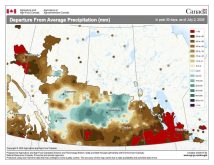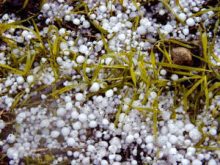Last issue’s forecast started off on a good foot as it correctly forecasted the complex area of low pressure that brought rain, freezing rain and snow to a large portion of southern and central Manitoba last Wednesday and Thursday. It was also correct in that the low would not bring large amounts of snow. Where things went wrong was the lack of cold air pushing in behind the system. This lack of cold air kept the low from really winding up, and it also meant the cold temperatures that usually follow this type of system just did not materialize.
Read Also

Thunderstorms and straight-line winds
Straight-line winds in thunderstorms can cause as much damage as a tornado and are next on our weather school list exploring how and why severe summer weather forms.
The big question for this forecast period is whether the forecasted switch in the weather pattern toward more seasonable, colder temperatures will take place. Each day the weather models are keeping with the prediction, but each day the cold weather seems one day further away and a little less cold. With that in mind, this is what may happen during the last seven to nine days of the month.
To begin this forecast period the weather models show an area of low pressure dropping out of northern Alberta, bringing with it a quick shot of snow either on Wednesday or Thursday. As with most systems this winter, it looks as if it will weaken as it moves across our region and only bring a few centimetres of snow at most. It does look like arctic air will push in behind this low, bringing sunny skies but colder temperatures by the weekend. While it will be colder, it does not look like this will be a strong push of cold air, as the really cold air will remain well to our north. Expect daytime highs in the -12 to -15 C range with overnight lows around -24 C. It may feel a little colder depending on exactly where the centre of the arctic high tracks. Currently, it looks like it will be to our west, which will place us in a breezy northerly flow.
This arctic high looks to prevail into the early part of next week, with only slow moderation in temperatures. The high will eventually weaken and slide off to our east or southeast, allowing our flow to become more westerly and temperatures to moderate back to above average toward the end of the month.
Usual temperature range for this period: Highs, -6 to -23 C; lows, -34 to -16 C.




















